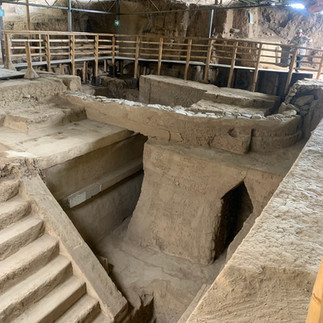Kaminal Juyu Archaeological Site
- Juan Francisco Rodas
- Jul 12
- 3 min read
Updated: Jul 28
The archaeological site of Kaminaljuyú is one of the most important and fascinating sites in Mesoamerica, and what makes it particularly unique is its location: it is located within the limits of Guatemala City, in Zone 7.
Below is some relevant information about Kaminaljuyú:
1. Origin and Meaning of the Name:
The name "Kaminaljuyú" originates from the K'iche' language and translates to "Hill of the Dead" or "Hill of the Ancestors," referring to the numerous burial mounds and funerary sites located at the site.
Some researchers suggest that its original name in ancient times may have been "Chiih Witz" or "Hill of Maguey" in Poqom.
2. Antiquity and Period of Occupation:
Kaminaljuyú is one of the oldest and longest-occupied sites in Mesoamerica. It is estimated to have been inhabited from around 1200 BC (Early Preclassic) until after 900 AD (Early Postclassic).
Its period of greatest flourishing was during the Late Preclassic (approximately 400 BC–100 AD), when it became the most important pre-Hispanic regional capital of the Guatemalan central highlands.
3. Architecture and Structures:
Unlike other Mayan sites built with limestone, Kaminaljuyú primarily used adobe and compacted earth (talpetate) for the construction of its pyramids and platforms. This makes its structures more susceptible to natural deterioration and urban growth.
Originally, the site had around 200 to 300 pyramidal mounds and platforms spread over a large area (estimated at up to 5 km²).
Ball courts, stelae (carved stone monuments), zoomorphic sculptures, and elaborate ceramics have been found. Many of the most significant pieces are on display in the National Museum of Archaeology and Ethnology and the Miraflores Museum..
4. Cultural and Commercial Importance:
Kaminaljuyú was a crucial center for trade and control of strategic routes. Its location allowed it to be a link between the Pacific coast (salt, shells), the highlands (cacao), and the Maya lowlands (jade from the Motagua Valley, feathers, jaguar skins).
It is believed to have had direct control over obsidian sources such as El Chayal, a vital resource in Mesoamerica.
It presents evidence of strong influence from Teotihuacán (ca. 400 AD), suggesting important trade relations and even, for some, possible military domination or significant cultural exchange. The presence of Teotihuacan architectural and ceramic styles is noted.
The Site Today:
Unfortunately, the rapid growth of Guatemala City has consumed most of the archaeological site. Of the hundreds of original mounds, only about 33 visible structures remain within a protected archaeological park in Zone 7.
The Kaminaljuyú Archaeological Park is a small fraction of the original size, but it is the only large part of the site that has been protected from urban development. It offers a visitor center and trails to explore the preserved mounds.
Other sections of the site are scattered beneath buildings, shopping centers (such as the Miraflores shopping center, which has its museum with exhibits of finds from the area), and residential areas.
Visit to the Kaminaljuyú Archaeological Park:
Location: Calzada San Juan 30 Avenue, Zone 7, Guatemala City.
Hours: Normally Monday to Sunday, 8:00 AM to 4:00 PM (recommended to check for changes).
Admission: Q5 for locals, Q50 for foreigners (this may vary; please confirm).
Guided tours are often offered, especially on weekends.
Visiting Kaminaljuyú is a unique experience, allowing you to see an important vestige of Mayan civilization in a modern metropolis, serving as a reminder of the deep history that lies beneath the city.


























Comments